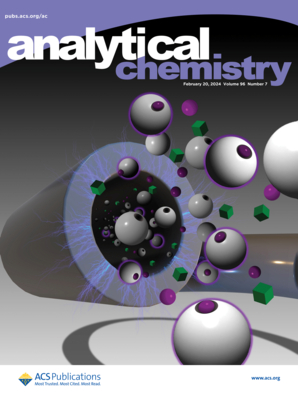硒化氢可触发供体和分析物替代荧光探针的一般策略。
IF 6.7
1区 化学
Q1 CHEMISTRY, ANALYTICAL
引用次数: 0
摘要
硒化氢(H2Se)是含硒生物分子生物合成的前体,也是一种潜在的一氧化氮(NO)样气体递质。H2Se传递和检测的化学工具对于探索硒的生物学和医学至关重要。然而,仍然缺乏可触发释放H2Se的通用平台,并且不不可逆消耗H2Se的H2Se荧光探针尚未报道。在此,我们报道了一种用于H2Se捐赠和检测的快速分子内芳基硫醇激活芳基硒酰胺(general FITA)的通用平台。我们利用自焚工艺对芳基硫醇进行了可控的脱保护,并开发了第一个硝基还原酶触发和活性氧触发的H2Se供体。我们利用一般的FITA基序构建了第一个H2Se分析物置换探针,该探针与H2Se反应后产生荧光响应并释放H2Se,从而在检测H2Se捐赠时强调了分析物的稳态。我们预计,这些定义明确的化学物质将促进具有治疗潜力的先进H2Se工具的发展。本文章由计算机程序翻译,如有差异,请以英文原文为准。
A General Strategy for Triggerable Donors and Analyte-Replacement Fluorescent Probes of Hydrogen Selenide.
Hydrogen selenide (H2Se) is the precursor for biosynthesis of Se-containing biomolecules and a potential nitric oxide (NO)-like gasotransmitter. Chemical tools for H2Se delivery and detection are crucial for exploring selenium (Se) biology and medicine. Nevertheless, general platforms for triggerable release of H2Se remain lacking, and H2Se fluorescent probes that do not irreversibly consume H2Se have not yet been reported. Herein, we report a general platform of the fast intramolecular arylthiol-activated arylselenoamides (general FITA) for H2Se donation and detection. We utilized self-immolative processes to controllable deprotection of an arylthiol for the tandem FITA and developed the first examples of nitroreductase-triggered and reactive oxygen species-triggered H2Se donors. We leveraged the general FITA motif to construct the first H2Se analyte-replacement probe which, upon reaction with a H2Se, generates a fluorescence response and releases a H2Se, thus underscoring the analyte homeostasis during detection of the H2Se donation. We anticipate that these well-defined chemistries will promote the development of advanced H2Se tools with therapeutic potential.
求助全文
通过发布文献求助,成功后即可免费获取论文全文。
去求助
来源期刊

Analytical Chemistry
化学-分析化学
CiteScore
12.10
自引率
12.20%
发文量
1949
审稿时长
1.4 months
期刊介绍:
Analytical Chemistry, a peer-reviewed research journal, focuses on disseminating new and original knowledge across all branches of analytical chemistry. Fundamental articles may explore general principles of chemical measurement science and need not directly address existing or potential analytical methodology. They can be entirely theoretical or report experimental results. Contributions may cover various phases of analytical operations, including sampling, bioanalysis, electrochemistry, mass spectrometry, microscale and nanoscale systems, environmental analysis, separations, spectroscopy, chemical reactions and selectivity, instrumentation, imaging, surface analysis, and data processing. Papers discussing known analytical methods should present a significant, original application of the method, a notable improvement, or results on an important analyte.
 求助内容:
求助内容: 应助结果提醒方式:
应助结果提醒方式:


